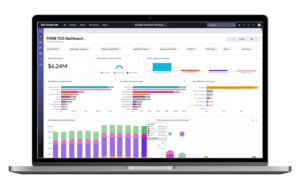The first, and arguably the most important, step in launching an ITFM program is to gain internal buy-in across both executive leadership and affected stakeholders. Without their support, the program will face a long, uphill battle — a battle that few IT Leaders can successfully navigate.
Thankfully, a solid business case can make the process of securing buy-in far simpler.
From a high level, there are four core components of any ITFM business case:
- Potential value for each user/persona group
- Anticipated savings and optimization opportunities
- Estimated cost to launch and maintain the program
- Estimated cost of sustaining the status quo
Let’s break down each component to understand its place in the architecture of an effective ITFM business case.
Defining Value by Persona
The foundation of a solid business case is built with a clear understanding of each core persona the program will impact, as well as the value they’re positioned to receive. In general, there are four standard personas to consider:
- The CIO/IT Leadership
- The CFO
- The Business Leader/IT Consumer
- The IT Finance Department
Here’s a brief summary of the key benefits a successful ITFM program can provide to each persona group across the business:
The CIO/IT Leadership
- Showcase the true value of IT
- Trim waste to drive innovation
- Reduce questioning and attacks of spend
- Garner support to fund new initiatives
- Increase alignment with the business
- Build trust and credibility
- Govern spend in multiple dimensions (Run/Grow/Transform etc.)
The CFO
- Improve accuracy and predictability
- Ensure funds are spent for maximum value and impact
- Reduce needless padding and boost accountability
The Business Leader/IT Consumer
- Gain full transparency of costs and their underlying drivers
- Expose new levers to control costs and prevent overconsumption
- Understand exactly what IT delivers in exchange for spend
The IT Finance Department
- Minimize time and effort required for budgeting and forecasting
- Transition from processing and reporting to analysis and insight discovery
- Reduce length of monthly close cycle
- Answer questions faster and with greater detail
- Automate manual processes to reduce effort and error
Keep in mind, this isn’t necessarily an exhaustive list. Depending on existing processes and organization structure, other potential benefits may also exist.
To capture all potential value a new ITFM program could deliver to each persona, meet with each persona group across the business to truly understand their needs, wants, and pains.
Every organization is different, and without consulting each persona group directly, there’s a good chance you’ll miss key benefits they could reap from the program.
Identifying Anticipated Savings and Optimization Opportunities
Building on the potential value defined by each persona group, every business case should include a summary of anticipated tangible benefits. When we say tangible benefits, we’re referring exclusively to benefits that result in measurable cost savings or avoidance.
Of course, there’s no universal guarantee for the savings each organization will achieve.
But by looking at what other organizations have accomplished — and pairing that information with a deep understanding of your own organization — it’s possible to calculate a “good enough” assumption to inform the business case and guide an intelligent decision making process.
That said, here are several of the most notable cost savings and optimization wins you can expect a mature ITFM program to deliver.
Vendor Management
There are two avenues of optimization for vendor spend: 1) identifying redundant or unused contracts, and 2) consolidating related contracts across separate vendors to a single vendor, i.e. reducing the total number of vendors in the portfolio, to leverage economies of scale and negotiate better pricing.
In one instance cited by Gartner, an organization who pursued the second avenue alone was able to reduce total vendor spend by 20%.
Application Rationalization
Over time, all organizations accumulate some degree of application portfolio waste. That waste comes in many forms: idle or over-provisioned apps silently burning resources, duplicative apps driving unnecessary maintenance and support costs, or apps that simply aren’t delivering sufficient business value to justify their cost (to name a few).
But with an accurate, transparent view of costs for all applications in service — along with a cost model that maps application costs to business functions — these issues become far easier to spot; and after capturing the low hanging fruit, organizations are equipped to continually optimize TCO and business value for each application in the portfolio.
As a point of reference for what an effective app rat initiative can accomplish, consider Gartner’s example of BT Innovate & Design, which reduced its portfolio of 2,500 applications by 30% over three years.
Infrastructure Audit
Unused or over-provisioned infrastructure is present in every IT organization, and it’s exceedingly difficult to eradicate without granular transparency of costs. And according to a review of several research reports, infrastructure waste could be as high as 30% on average worldwide.
Implementing sound ITFM principles allows IT Leaders to easily spot waste across all infrastructure assets (including cloud), then decide whether to exit or reallocate.
Delivery Cost Reduction
Many IT organizations still don’t have a firm grasp on the specific services they deliver to the business, how much those services truly cost, and what can be done to optimize those costs. By introducing a service cost model and understanding all underlying cost drivers, it becomes far simpler to create accurate unit rates and optimize them continually, which often results in a savings of 20-30%.
Demand Management
After working to optimize internal service delivery costs, IT organizations can pursue further savings by managing demand through a monthly showback or chargeback (bill of IT). When IT consumers can see and understand their monthly costs — and what’s being delivered for those costs — they’re able to intelligently guide their own usage. A monthly bill of IT also offers opportunities to drive adoption or discontinuation of specific technologies through strategic pricing, and IT Leaders can create tiered service options to match consumer needs as well.
McKinsey & Company reports an effective demand management strategy can yield a 15-20% efficiency savings over 3-4 years.
Estimating Costs to Start and Maintain the Program
With a clear understanding of what the organization stands to gain by implementing a new ITFM program, the next step is to estimate startup and maintenance costs.
This exercise should also provide a rough estimate for time-to-value, e.g. how long it will take to recoup startup costs and begin realizing ROI, by weighing the anticipated savings and benefits against the required investment to start the program.
Critical action items to complete for this portion of the business case include:
- Assess data readiness: Most organizations have enough good data to start an ITFM program, but, in some cases, additional resources may be required to identify, cleanse, and aggregate data sources.
- Analyze existing business processes: It’s important to review all existing processes, checking for integrity and efficiency, before automating them in a software solution. And again, additional resources may be required depending on the current state.
- Judge internal capabilities: Take time to inventory your staff and their capabilities. This is a crucial step to identify potential gaps and work to fill them before launching the program.
- Request pricing from potential vendors: Software costs represent a large portion of the investment required to launch a new ITFM program. After researching potential vendors, inquire on their pricing terms to get a rough idea of license costs.
- Estimate ongoing maintenance costs: The cost to maintain a software solution — upgrades, enhancements, bug fixes, etc. — can vary depending on your vendor of choice and specific contract terms. These costs can also fluctuate if you plan to utilize internal resources to handle any amount of ongoing maintenance.
- Estimate training and staffing costs: Combine the information you’ve gathered internally with what you’re hearing from potential vendors to form an estimate for training and staffing costs. In many cases, new hires are minimal, if needed at all. But there can be notable cost to socialize the program and ensure stakeholders across the business understand how to engage with and reap value from the program.
- Meet with potential implementation partners: Depending on data readiness, existing processes (and their quality), and internal skills/capabilities, an external implementation partner may be needed. Potential vendors can help you judge the need for third-party support; based on that guidance, spend some time investigating consultant services and costs.
Estimating Costs of Not Starting the Program
Depending on budget size, complexity of existing systems, number of consumers, and many other factors, the cost of starting a new ITFM program might not be justified. That’s why it’s so important to assess the organization’s current state to make an informed decision.
In other words, what is the cost of doing nothing?
Without a clear answer to that question, there’s no objective way to judge if a new program is worthwhile; every organization must weigh the consequences of maintaining the status quo against the potential costs and benefits of a new ITFM program.
The simplest way to capture potential costs of delaying a new program is to step back and consider the “why” that’s driving organizational interest in ITFM.
What are the needs, pains, and wants that sparked this discussion in the first place, and what are the consequences of those things going unaddressed?
The answers to those two questions will vary by organization, and they may be difficult to quantify. But with the right diligence and investigation, capturing a useful estimate for the impact of doing nothing is possible.
- Maybe the CIO is struggling to innovate, frustrated by bloated run budgets and struggling to secure additional funding from the business due to lack of trust.
- Perhaps cost recovery is an issue, because of constant disputes and short/delayed payments (often a challenge in public sector IT).
- Or maybe there’s too much time and effort associated with annual budgeting and monthly forecasting, in addition to confusion, conflict, and error.
These are just three examples from the long list of potential “why’s” that could apply to your organization. Define them all and attempt to quantify the impact of ignoring them.
This exercise will bring another layer of clarity to the business case — ensuring potential benefits are examined in-context with the reality of today’s current environment.
Key Takeaways
As you work to build out your business case, and when you move to present it internally, here are a few additional pieces of guidance to keep in mind:
Don’t overemphasize potential savings – Although a successful ITFM program does reduce costs, it should ultimately shift the business’s focus from cost to value. So as you communicate the potential worth of a new program, don’t let the tangible benefits of savings and optimization steal too much attention from intangible benefits like operational efficiency and business alignment. Be sure to highlight both equally.
Stay mindful of your organization’s unique traits – There’s no “one size fits all” formula to create an effective ITFM business case. Although the components explained in this post are applicable to nearly all organizations, there many others that will only apply to yours. That said, be as rigorous as possible in your search for value narratives based on the unique traits of your organization.
Be ready to field objections – No matter how comprehensive a business case may seem, there will always be questions and objections. Do your best to anticipate pushback, and prepare accordingly to deliver fast and compelling responses.





